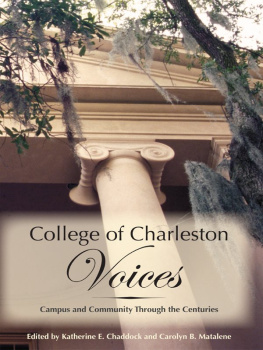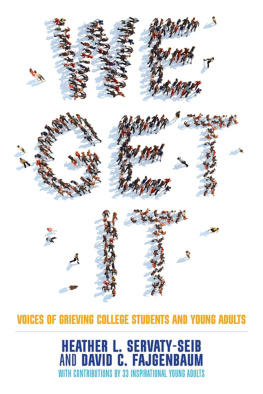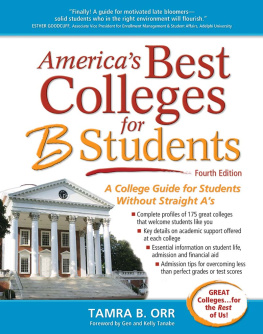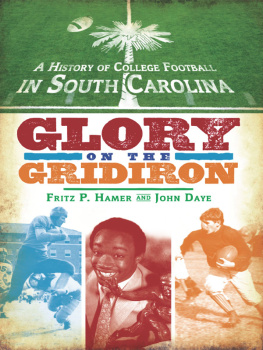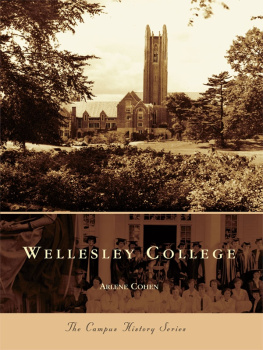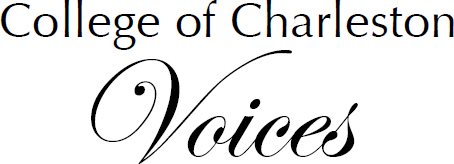

Published by The History Press
Charleston, SC 29403
www.historypress.net
Copyright 2006 by Katherine E. Chaddock and Carolyn B. Matalene
All rights reserved
Cover Image: The columns of Randolph Hall. Courtesy of College of Charleston, photo by Loren Bridges.
First published 2006
e-book edition 2012
ISBN 978.1.61423.560.6
Library of Congress Cataloging-in-Publication Data
College of Charleston voices : campus and community through the centuries / edited by Katherine E. Chaddock and Carolyn B. Matalene.
p. cm.
Includes bibliographical references and index.
print ISBN 978-1-59629-091-4 (alk. paper)
1. College of Charleston--History--Sources. I. Chaddock, Katherine E. II.
Matalene, Carolyn B.
LD891.C62C64 2006
378.757915--dc22
2006015519
Notice: The information in this book is true and complete to the best of our knowledge. It is offered without guarantee on the part of the authors or The History Press. The authors and The History Press disclaim all liability in connection with the use of this book.
All rights reserved. No part of this book may be reproduced or transmitted in any form whatsoever without prior written permission from the publisher except in the case of brief quotations embodied in critical articles and reviews.
Dedicated to all the librarians and archivists who make the past possible
Contents
Preface
In the heart of downtown Charleston, South Carolina, on narrow George Street, stands a two-storied gatehouse known as the Porters Lodge. Four Tuscan columns adorn this Roman triumphal arch, and its rosy stucco is faded by age and spotted with moss. The Lodge announces the College of Charleston, a name asking to be spoken with heavy emphasis on Charleston, that small southern city so momentously enmeshed in the history of the colony, of the country and of all its wars. The uniqueness of the city itself has always been a powerful influence on every local institution, on every citizen.
Charlestonians love their city with a devotion they readily admit is irrational. Josephine Pinckney, a student at the College in 1919, has the character Lucien in her best known novel Three OClock Dinner muse: The swampy area on which he had been born, had lived, and hoped to die was probably in no way superior to similar acreages but nothat was hardly truesome special lucence bathed this plot of ground, he insistedthis precious stone set in a slightly muddy sea. For people loved it with extravagancein spite of its absurdities, its gross failures. Perhaps because of them
An irrational love of Charleston is common indeed, here where a sense of the past seems to hang in the airespecially in the College quadrangle. Those who walk through the gateway of the Porters Lodge enter one of the most beautiful spaces in the city and one of the loveliest college campuses anywhere. Live oaks draped with Spanish moss line the brick walkway that leads from the Lodge to the Cistern, the raised circle of grass that was once a public water supply, catching the rainwater from the leaking roof of College Hall. In the twentieth century, College Hall was renamed Randolph Hall for Harrison Randolph, made president of the College at age twenty-six in 1897 and its stalwart leader for more than forty years. Fittingly, Randolph Hall serves as both spiritual and physical center of the campus, the six great Ionic columns of its raised and pedimented porch attesting to the seriousness and permanence of the College of Charleston.
Since its founding, the College of Charleston has for more than two centuries provided higher education for the youth of the city. Then, a few professors could and did constitute the entire faculty for the student body of fewer than one hundred local young men. Today, the faculty numbers some two thousand and the student body over ten thousand; they now come from every state and more than seventy countries. But todays thriving institutionwith its six separate schools, carefully preserved old buildings and graceful new onesemerged only through hard-fought victory over adversity. In fact, the College weathered so much adversitylack of funds, dilapidated buildings, leaking roofs, yellow fever, unruly students, Civil War, earthquakes, hurricanes, racial tensionsthat its very survival seems miraculous.
But survive it has, this college that Charleston invented and nourished and sustained. And it is naturally as special, precious and unique as the city itself. Charlestonians, in fact, constitute what biologists call an endemic species. Thus, from the beginning, graduates of the College of Charleston became the doctors and lawyers, teachers and ministers, merchants and civil servants of the town, dutifully carrying on the planter tradition and revering its code of behavior. Faculty of the College also revered the past, especially the classical tradition, and required all students to take three years of Latin and Greek until as late as the 1970s. Some notable alums, however, remembered a different pastone that included the evils of slavery and racismand worked very much against the grain. John C. Fremont, class of 1836, served as a major general in the Union Army. Judge J. Waties Waring, class of 1900, wrote the dissenting opinion (Segregation is per se inequality) in Briggs v. Elliott, a case absorbed into the epoch-making Brown v. The Board of Education. But for most graduates of its College, Charleston seemed a harmonious place. Thus, Robert Marks, a student in the 1920s, returned to his native city in the 1970s and remembered the sweetness of the campus, the gentleness. Most of the professors had gone to the College themselves, so there was no separation between town and gown, the gown was the town.
The history of the College, so subject to local conditions, also provides a telling chapter in the development of American higher education from colonial times to the present. In 1935 the Board of Trustees published history professor J.H. Easterbys carefully researched work, The History of the College of Charleston, and there has been no institutional history since. We have not tried to write one. Rather, using primary sources, we have allowed participants to tell the story of the college in their own voices.. To these documents, we have added only brief explanatory introductions. Among the most persistent voices is the anonymous one that insists upon a founding date of 1770. Thus, the College calls itself the thirteenth oldest academic institution in the country and the nations oldest municipal college. The very nature of the College as a city school has, however, confronted us with unique difficulties. For the first century and half, students at the College had no need to write letters home. They all lived there. Since so few letters were written, we have had to find the voices of Charlestons College in other genres: minutes, newspapers, literary magazines, yearbooks, journals, diaries and memoirs. Some of the texts we recovered were written by students or alumni from battlefieldsor prisons.
Though it has been said that the business of America is forgettingimmigrants striving to partake in the national identity abandon their mother tongues and ethnic originsin marked contrast, the business of Charleston has always been remembering: remembering lands and servants, ancestors and kinfolk, rituals and romances, achievements and even defeats. As one of the Colleges most famous nineteenth-century graduates, James Dunwody Brownson DeBow, wrote elegaically in his college reminiscence: Bring me back the beautiful pastthe youth of hope and joythe heart fluttering with each new prospect, and chasing away upon light wing the momentary intrusion of care. Thus, many of our sources are reconstructions of the past, memoirs written long after the authors actual college experience and inevitably colored by that golden haze of memory. But who is to say which is more real: ones years in college or ones memory of them?
Next page
